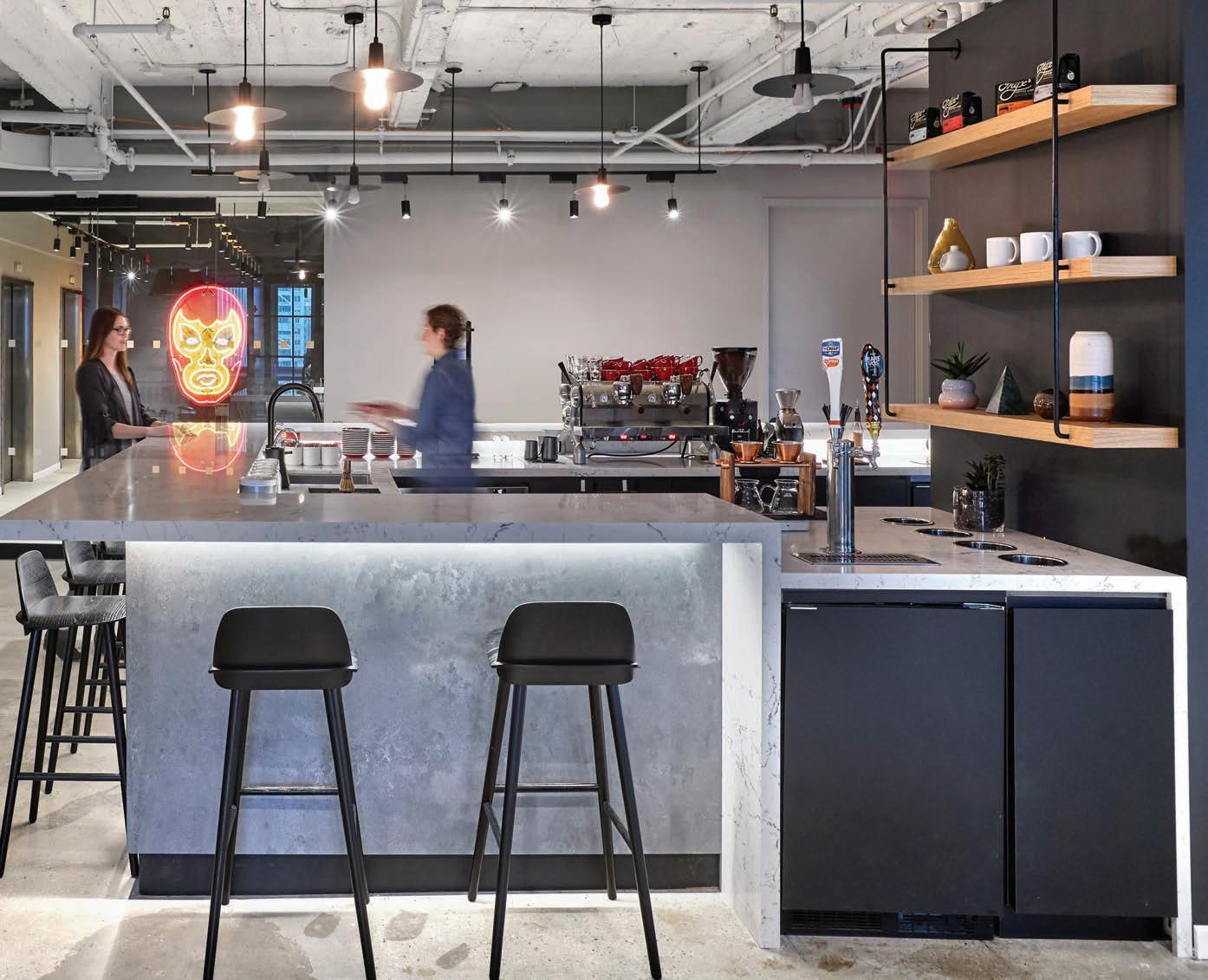
9 minute read
Chapter 6 “Like Lighting a Match”
Strong relationships with staff and clients were always the bedrock of the Kleinberg business and continued to be as the firm expanded. Whether with developers, landlords, brokers or design clients, MKDA relationships last for decades. As companies grew, acquired other companies or otherwise changed, they came back to MKDA to design for the new entity.
“We have always been relationship people and that is how we have developed the business historically,” Michael explains. “We have always been tight with the commercial real estate community of brokers and consultants, and as we developed closer relationships with them over the years, they would refer us to tenants in the industry.” The commission to design headquarters for Polygram Records was one of those referrals. According to Michael, it came from a contact MKDA made years earlier with a brokerage called Williams Real Estate. Sometime in the 1980s, when Polygram decided to consolidate its multi-label operation under one roof, Williams recommended MKDA to design the space. High-profile music labels included icons like Deutsche Grammophon, Island, Decca, London and Mercury, among others, each of which would have its own floor. Eventually, Polygram had about 10 floors, each measuring 30,000 square feet, in the new, SOMdesigned Worldwide Plaza complex, completed by Zeckendorf Development in 1989.
Advertisement
Often, the Kleinbergs were in the right place at just the right time with the right idea, like developing small space programs and pre-builts in the ’80s and ’90s, when buildings were getting bigger than they’d ever been.
“We came up with the creative ideas for positioning a
MKDA designed Polygram Records’ 10 floors of offices in Worldwide Plaza, above, designed by SOM and opened in 1989.
Polygram Records’ Corporate headquarters.
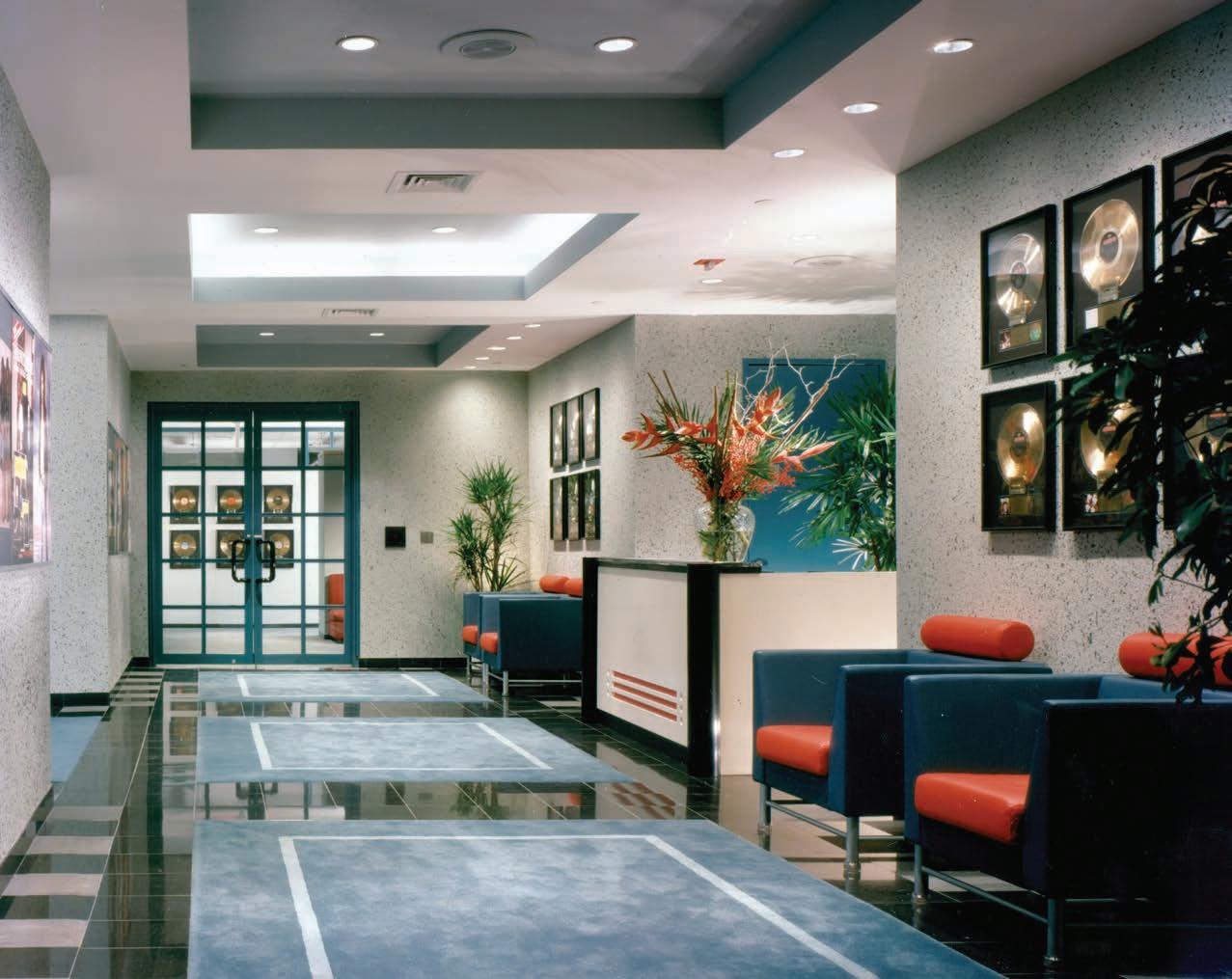
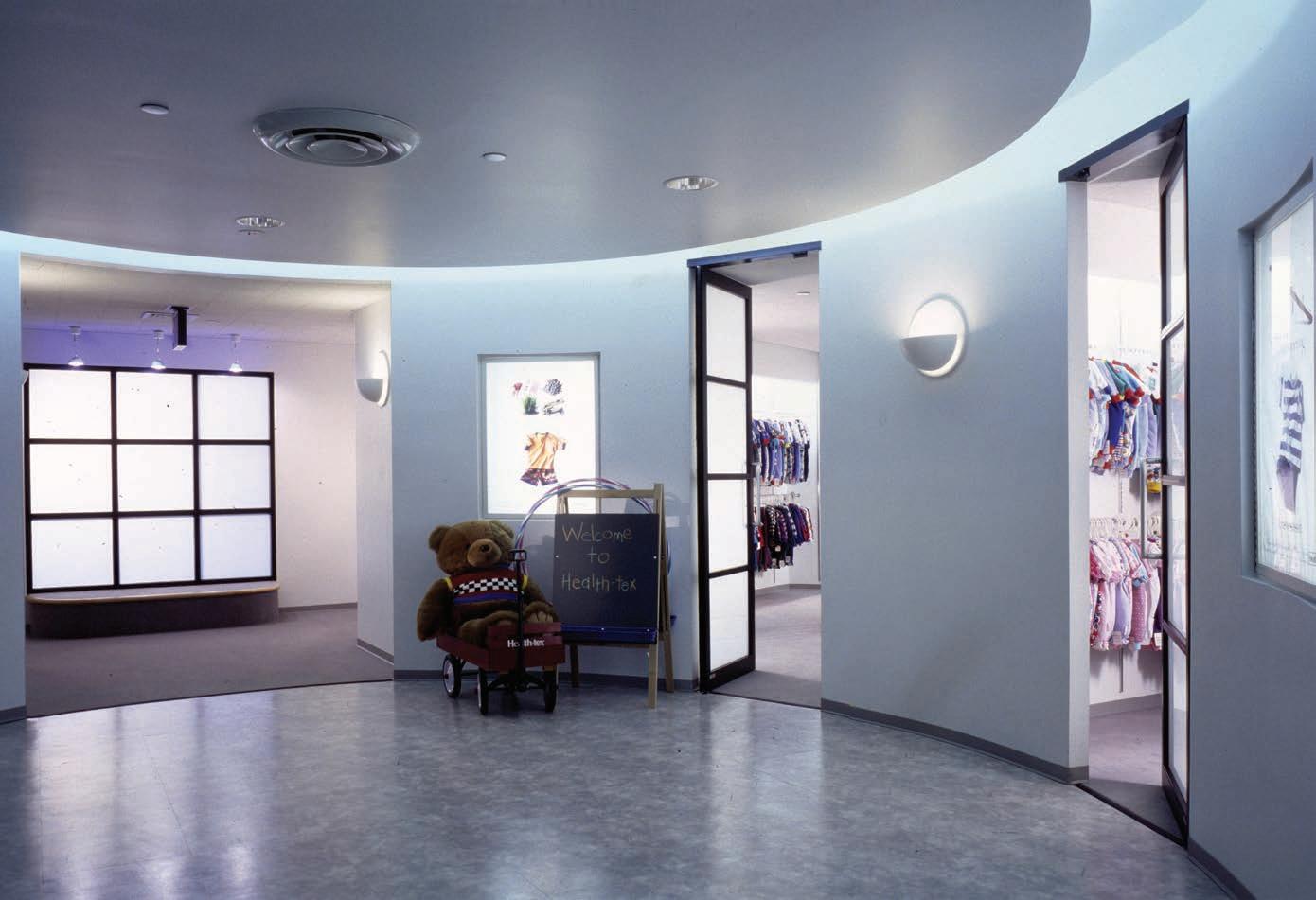
Health Tex was one of MKDA’s clients in the Childrenswear Building, 100 West 33rd Street, the former Gimbel’s department store.
building, and determining what tenants wanted, to help landlords bring the tenants in,” Michael says. “Landlords needed to attract tenants, so we would show how spaces could be laid out, divide and design floors, and show how you would actually build them.”
This approach caught on early and spread quickly, helping fuel massive growth in the real estate market. Suddenly, developers were heading west of Seventh Avenue into what was uncharted territory in office construction terms, creating unlimited opportunities for Kleinberg. He was only too eager to collaborate with the landlords as they ventured away from the Midtown core.
“He really started to pick up steam at some point in the ’70s, but in the ’80s, he was at the forefront,” Michael says. “It was like lighting a match.”
Building followed building as the demand for the highly marketable pre-built suites heated up. Projects included the 60-story Carnegie Hall Tower, designed by Cesar Pelli & Associates (now Pelli Clarke Pelli Architects), developed by Rockrose and opened in 1991, where MKDA still does work today. Also in the 1990s, the firm developed one of the very first finished high-end spaces in the former Barney’s building at 660 Madison Avenue, working with what was then Newmark (now NKF, Newmark Knight Frank), while earlier, in another noted development, the Kleinbergs worked with Silverstein Properties to redevelop the former Gimbel’s department store at 100 West 33rd Street. As it morphed into the Manhattan Mall, the Kleinbergs helped turn the top four stories into what would become known as the Childrenswear Building. As happened in the ’60s and ’70s with 1411 Broadway, MKDA also got the contracts to design showrooms for many of the brands located there, including Bugle Boy, Hushpuppies, French Toast, Carter’s and Health Tex.
The apparel industry remained a mainstay for MKDA throughout the ’80s and ’90s. The firm designed showrooms for brands like that of super model Christy Brinkley, Head Sportswear, Gottex of Israel and Alfred Dunner, in addition to the Calvin Klein headquarters on West 39th Street. MKDA also began to diversify, designing showrooms for Borghese cosmetics, Springs Mills and Rosenthal Crystal, and retail stores for Ascot Chang and Shanghai Tang. In the 1990s, the firm designed the landmark
Magic Johnson movie Carnegie Hall Tower where MKDA helped market the property.

The sleek entrance to the New York offices of Murjani Group.
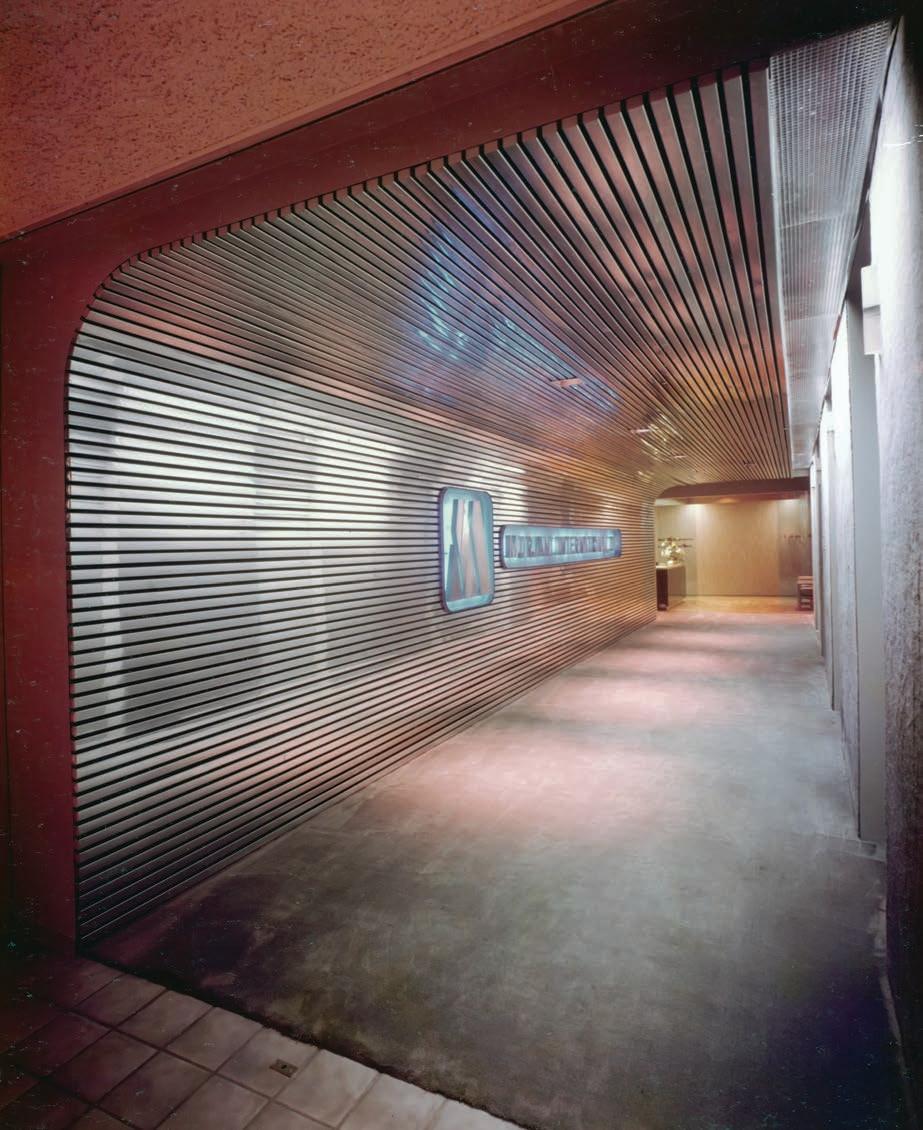
theater complex on Frederick Douglas Boulevard and West 124th Street in Harlem.
The continued presence of apparel brands on MKDA’s client roster into the 1980s and 1990s is the legacy of the company’s strategy of being landlord-focused. But while Kleinberg may have gotten his start working with landlords in apparel- and textile-centric buildings, his client list diversified as his clients’ buildings did. Financial services companies came calling, resulting in commissions from AIOC Corporation, American Federation of Musicians, Apple Bank, Enskilda Securities, Fidelity Investments, Lexington Partners, MONY Life Insurance Company, Merrill Lynch, and US West Financial Services, among others.
MKDA’s currency was design expertise coupled with an acknowledged ability to market new property, deliver laser-focused programs for individual clients, and turn out the work on time and on budget. Unlike other design firms, MKDA was a full-service concern and unique in that respect. Kleinberg acted as an owner’s rep, project manager and construction manager, in addition to being a creative. He also saved clients money by eliminating middlemen and working directly with vendors.
According to Daniel DeSiena, MKDA executive vice president and director of design, Milo Kleinberg’s reputation as an innovator was of prime importance in the equation. “He was the one making sure we were on the cutting edge, including anything technological,” DeSiena recalls. “As much as he was an astute businessman with an Old World perspective in evaluating people and providing service, he was also extremely forward thinking technologically. He was always ahead of the curve.”
Kleinberg also knew which industries were waning and which were on the rise, and made sure the firm bet on the winners.
“We started moving into law firms, banks and financial services and, before long, that was our bread and butter,” DeSiena says. “We also did a lot of work for the City of New York, and combined facilities for the Council of Jewish Federations and United Jewish Appeal in New York and nationally.”
MKDA also innovated on the micro level, getting ahead of trends in office design, whether they apply only to one industry, like securities, or across the board. As the firm was once the primary trendsetter in showroom design, Kleinberg smoothed the transition
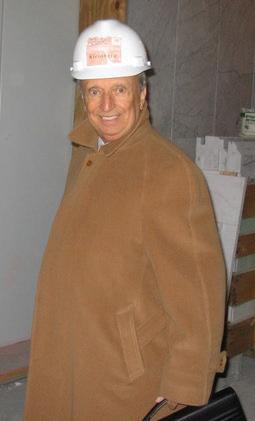
Kleinberg at a job site.
in office design to open plan offices and workstations from the kind of closed offices that were a long-standing tradition in the corporate world. Now, according to Kleinberg, some 90% of offices are open plan, except for the conference room. Companies embraced the notion for its effect on the bottom line.
“Companies benefit from the flexibility open plans allow because furniture can be adapted to any space and can be moved easily if the company requires it,” DeSiena explains. “It costs less than repeated complete buildouts as companies grow and move.”
According to DeSiena, there were also many successful collaborations with top suppliers of office furniture, such as Steelcase, Allsteel, Herman Miller, Knoll and Arnold Desk.
“We were always at the forefront of new things,” Jeffrey says.
Another contributor to MKDA’s success has always been continuity in its own staff. Wise hires means critical staff members spend their entire careers with the firm. “Finding good people is the hardest thing and we try to home-grow our staff as much as we can,” says Michael.
Indeed, Jack Maron was with MKDA for more than 40 years, and Daniel DeSiena, hired by Kleinberg in 1983, celebrated his 35th anniversary with the company in 2018. Geffner, while not on staff, supplied custom cabinetry for Kleinberg’s designs from the 1950s until he sold the family concern in the late 1990s.
DeSiena recalls how thrilled he was when Kleinberg hired him based on a rough drawing of a unit in the principal’s Riverdale apartment complex. At the time, DeSiena was working for the home furnishings division of Celanese. He happened to visit the Fifth Avenue showroom of Dakotah Creative Home Furnishings, manufacturers of decorative textile products. The design of the space so impressed him that he wanted to know who designed it, so he could ask him for a job.
“I saw the Dakotah showroom and knew instantly that I wanted to work for the company that designed it,” DeSiena says. “I loved the architectural forms, the deep colors, the play on tones—it was very geometric, avant garde and architectural, but also warm.”
Once in, he delighted in the colorful tapestry that was the staff. They were individualistic and talented and sometimes a bit eccentric, like Astrachan who, legend has it, climbed Machu Pichu in high heels.
“It was a fascinating collection of characters, men and women, each with a unique personality,” DeSiena remembers.
He was also taken with Kleinberg’s rigor (“On time and on budget!”), his European sensibilities, and the way he encouraged staff to be entrepreneurial. According to DeSiena, Kleinberg wanted each of them to act as
The blue of the ocean and the white of fine sand for the Gottex swimsuit reception area.
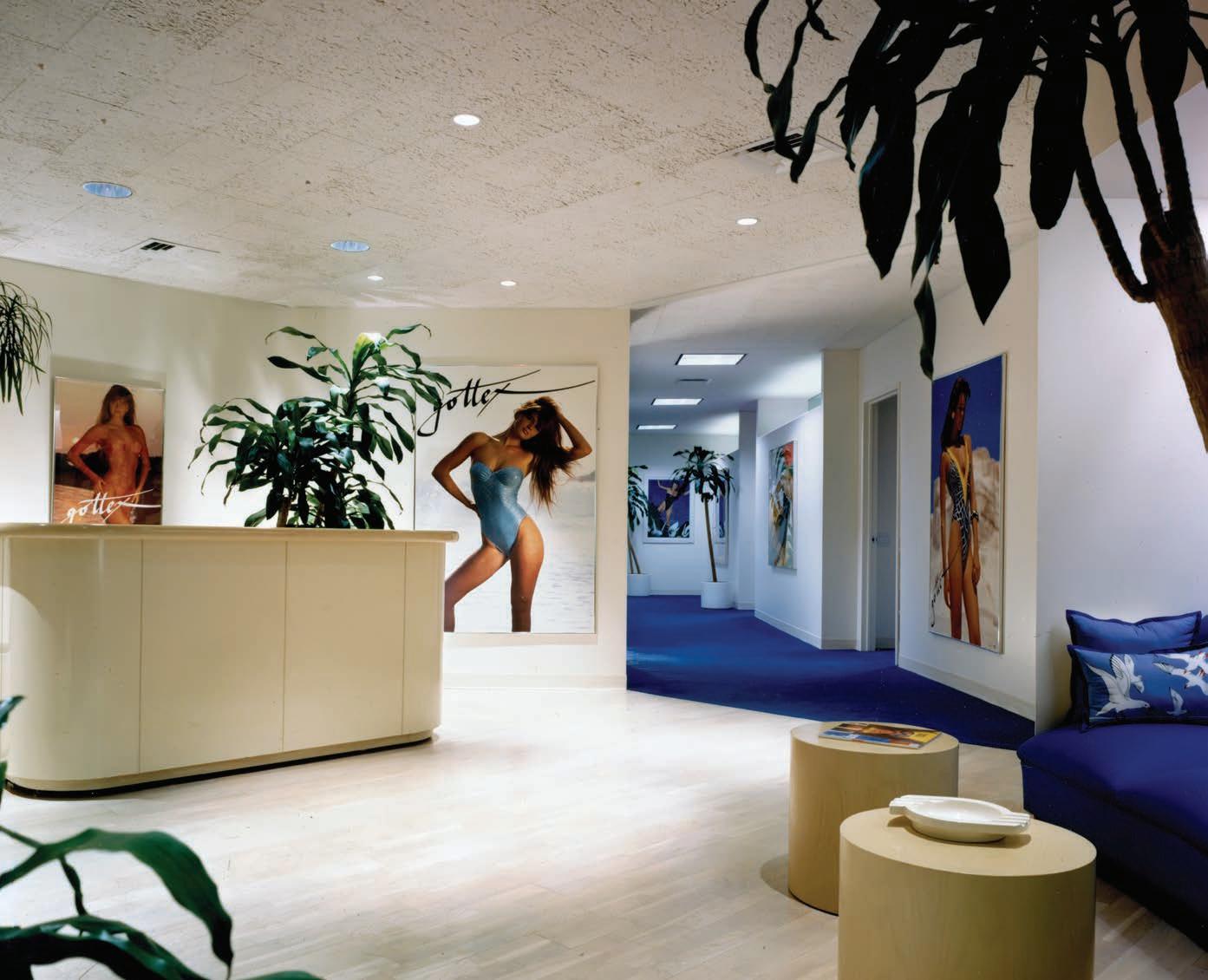
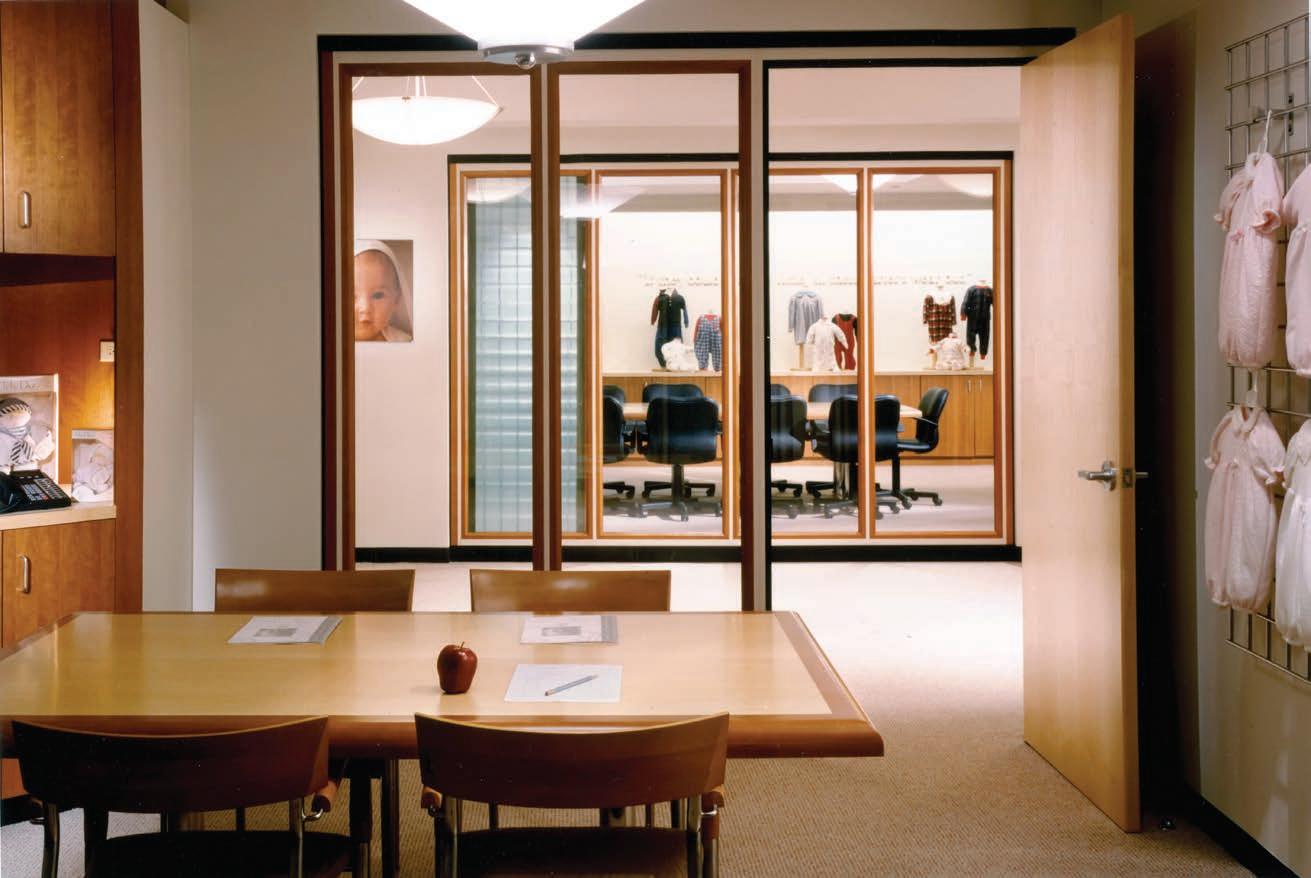
The Carter’s brand showroom and conference area in the Childrenswear Building.
though they were running small businesses and work as though every job was their very own. To that end, DeSiena says, Kleinberg demonstrated a confidence in staff abilities that fostered creativity and a highly productive kind of independence.
“If you could do it, he would let you do it,” DeSiena recalls. “It was an environment where you could flourish if you were meant to do so.”
That professional freedom, however, was in some ways countered by Kleinberg’s toughness, which, DeSiena notes, was, in turn, tempered by an even-handed way of dispensing demands on everyone across the board, family or not.
“He has always been tough and that teaches me how to be tough,” he says.
“You cannot be too thin-skinned in the business world.”
CHAPTER 7: DESIGN FIRM TO THE DEAL MAKERS
The Millennium brought with it a significant proliferation of new financial instruments that would take the banking sector into virgin territory, much like junk bonds did in the 1980s, but somewhat less distastefully. Hedge funds were a large part of that growth and, for MKDA, represented new opportunities, just as the fledgling apparel industry did for the firm decades earlier. Young start-ups in new buildings meant one thing: growth. It generated movement and repeat business for MKDA as it worked with landlords to drive initial leases, then move the companies into larger and larger spaces as they grew.
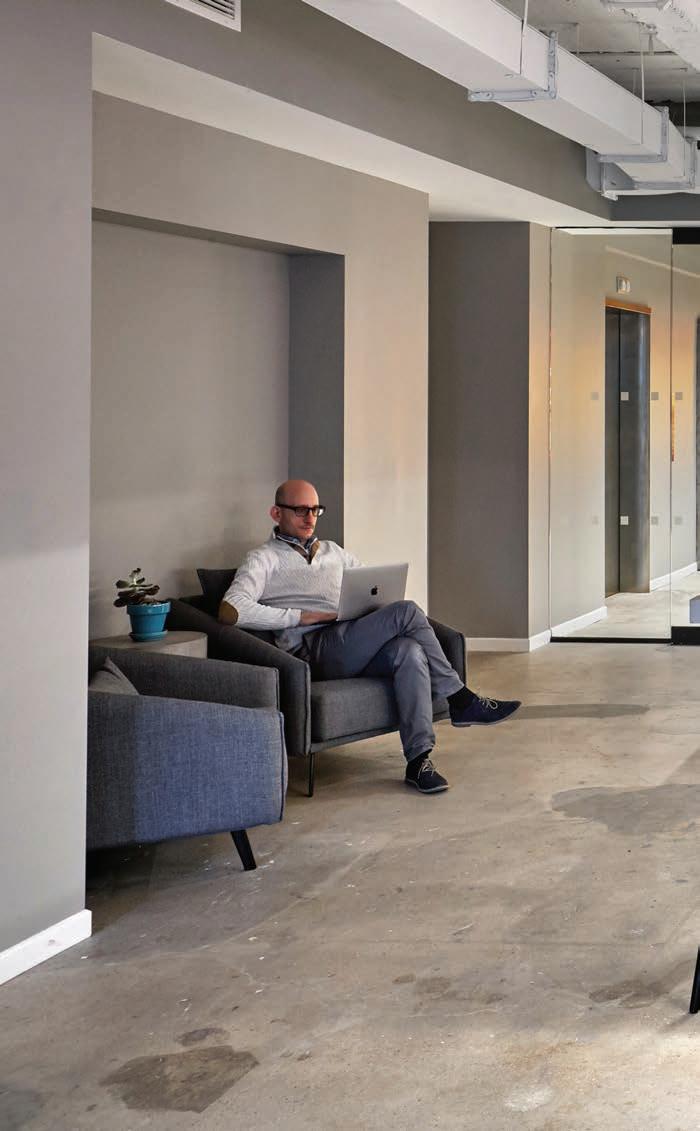
MKDA began designing for law firms Duane Morris & Hecksher, Kramer Levin Naftalis & Frankel, Ohrenstein & Brown, and Tenzer Greenblatt, in addition to the banks and financial institutions that began appearing on the roster as early as the 1980s. When hedge funds arrived on the scene sometime in the early 1990s, the firm was well placed to work with landlords courting the start-ups, and design the sorts of flexible space
Café designed for the New York offices of Shireson Associates, a strategic data science consulting
firm. PHOTOGRAPH: Garrett Rowland.
